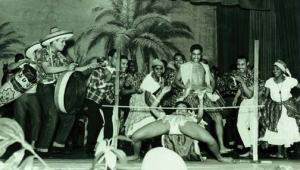1951
Cleveland, Ohio. First open air ‘Rock and Roll Show’, organised by DJ Alan Freed.

Summer: The Festival of Britain was a national exhibition held throughout the United Kingdom, which was a government-organised celebration of British science, technology, the arts and architecture, to aid the feeling of postwar recovery.
August 26-September 1. Edinburgh. Launch of the first Edinburgh People’s Festival, organised by communists, activists, nationalists and cultural workers in Scotland to balance the elite, frequently non-Scottish Edinburgh International Festival (founded in 1946), and to offer a competing voice to the 1951 Festival of Britain. Theatre, folk music, lectures, a conference ‘Towards a People’s Culture’, a festival club.
1952
August 17-September 7. Edinburgh People’s Festival. What we would now recognise as a socialist version of the Fringe, running over three weeks. Because key organisers were communists and other left activists, the Scottish TUC proscribed it and the Scottish Labour Party banned its members from involvement with it. (Let’s hear it for solidarity.) The event, a great success in 1952, fizzles out over next two years, but hear the political echos of the People’s Festival in the annual Fringe still today.
1954
Rhode Island, USA. First Newport Jazz and Folk Festival, billed as the ‘First Annual American Jazz Festival’, attracted audiences of over 13,000 over two days, and featured, among others, Dizzy Gillespie, Bobby Hackett, Billie Holiday, Lester Young, and the elusive Lennie Tristano. Miles Davis debuted at Newport in 1955.
Sidmouth, Devon. Early, perhaps first, folk music festival as a part of the Second English Folk Revival, a movement trying to construct a new national tradition of ‘radical Englishness’. The radical folk magazine Sing launched this year too. Sidmouth Folk Festival still going strong today.
1956
First Beaulieu Jazz Festival, organised by the Southampton Friday Night Traditional Club at Lord Montagu’s Palace House. Headlined by the Avon City Jazz Band. Attendance about 600 people, including some who camped the night before in the woods.
Butlins Holiday Camp, Clacton-on-Sea, Essex. Jazz Festival Weekend. Had ‘many of the ingredients of a proper festival’, according to Jeremy Sandford. Ted Heath, Johnny Dankworth, Shirley Bassey, USAF Rock ‘n’ Roll Group. £5 for a weekend ticket. 2,000 people catered for, 800 turn up.
1957
Beaulieu Jazz Festival, with advertising playing on the aristocratic connection (rather downplaying any democratic claims jazz frequently expressed for itself): ‘a combination of blue blood and the blues’.
1958
April 4-7. First Campaign for Nuclear Disarmament protest march from London to Aldermaston, Berkshire, the Aldermaston Weapons Research Establishment, raises the profile of both the issue of peace and the new organisation itself, founded in February 1958. The 53-mile march over four days at Easter means a community of protestors forms, 10,000 strong.
Beaulieu Jazz Festival, the first two-day event, with a large PA and tents for overnight campers. With its combination of outdoors pop music, youth audience and authorised camping as integral parts, this event is often considered the first proper pop festival in Britain. Note the conjunction with the formation of CND. Attendance 4,000 people.
Monterey, USA. First Monterey Jazz Festival. It will be established over the next decade as one of the West Coast’s premier jazz festival events.
September. ‘Notting Hill race riots’, London. 58 arrested in gang fights. A fortnight later nine white youths are imprisoned for four years for ‘nigger-hunting’.
1959

January. Notting Hill, London. West Indies Gazette organises a Caribbean Carnival.
Easter. CND now annual march, now from Aldermaston to London. 3,000 do the fifty miles over several days, and are joined for the last part in London, from the Albert Hall to Trafalgar Square, by 12,000 others in a national demonstration on Easter Monday. All the paraphernalia of a moving festival described in The CND Story: ‘jazz bands and guitars, songs and slogans, banners, placards and pamphlets … luggage vans, banner wagons, litter collectors and Elsan toilet teams; stewards, dispatch riders, first aid teams’.
Beaulieu Jazz Festival. Press reports begin to emphasise what Melody Maker called the ‘weirdies’ element of the audience, as antagonistic youth lifestyles increasingly feature in the burgeoning festival culture.
Paddington Town Hall, London. Mardi Gras, an early carnival-style celebration of West Indian music and dance in Britain.
